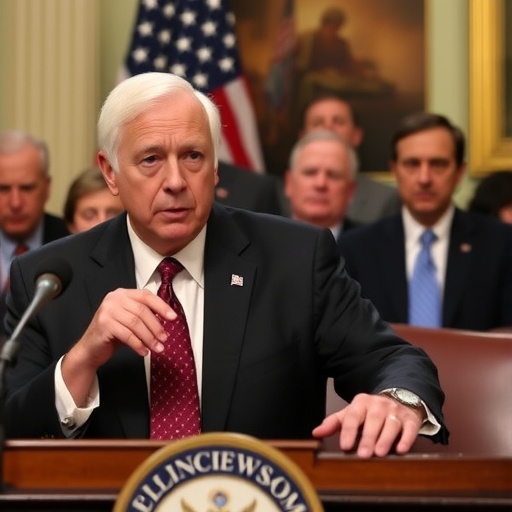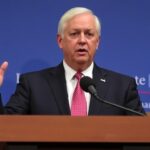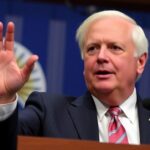Government shutdown Edges Toward Historic Record: Speaker Johnson and Republicans Dig In on Health Insurance Cuts
In a tense standoff that’s captivating the nation’s capital, Speaker of the House Mike Johnson warned Thursday that the ongoing Government shutdown could soon eclipse the record set during the 2018-2019 impasse, potentially lasting over 35 days if Democrats don’t relent on their push to alter proposed health insurance reductions. As federal agencies grind to a halt and essential workers remain unpaid, the impasse underscores deep partisan divides, with both Republicans and Democrats facing equal public scorn according to recent polls.
The conflict centers on a Republican-backed spending bill that includes significant cuts to federal health insurance programs, including reductions in funding for Medicaid expansion and Affordable Care Act subsidies. Speaker Johnson, a staunch conservative from Louisiana, has repeatedly stated that no compromise is possible without Democrats abandoning their amendments to preserve these provisions. “We’re not going to bend on fiscal responsibility,” Johnson declared in a press conference earlier this week, emphasizing the need to curb what he calls “out-of-control spending.” This unyielding position has prolonged the Government shutdown, now in its 28th day, threatening to disrupt everything from national park operations to air traffic control.
Historical context adds gravity to the situation. The longest previous government shutdown lasted 35 days from December 2018 to January 2019, costing the economy an estimated $11 billion in lost productivity, according to the Congressional Budget Office. If the current shutdown surpasses that mark by early December, it would not only break records but also amplify economic pressures amid lingering inflation concerns. Economists warn that extended closures could shave 0.2% off GDP growth in the final quarter of the year, hitting small businesses and consumer confidence hardest.
Johnson’s Unwavering Demands: Republicans Block Health Cuts Reversal
Speaker Johnson‘s firm grip on negotiations has become the linchpin of the government shutdown, with House Republicans rallying behind his strategy to enforce deep health insurance trims as part of a broader austerity package. The proposed cuts, totaling over $500 billion over the next decade, target inefficiencies in programs like Medicare Advantage and state-level Medicaid grants, which Johnson argues are bloated by Democratic expansions during the Biden era.
In a series of closed-door meetings this week, GOP leaders rejected a Democratic counterproposal that would restore 80% of the health insurance funding while adding $200 billion in tax hikes on high earners. “This isn’t about politics; it’s about protecting taxpayers from unsustainable debt,” Johnson told reporters, quoting fiscal hawks within his party who point to the national debt surpassing $35 trillion as justification. Senate Minority Leader Mitch McConnell echoed this sentiment, stating, “We can’t keep kicking the can down the road on entitlement reforms.”
Behind the scenes, the Republican strategy appears calculated. By holding the line, they aim to force Democrats into concessions that could appeal to moderate voters ahead of the 2026 midterms. However, internal GOP fractures are emerging, with moderate Republicans from swing districts voicing concerns over the shutdown’s backlash. Rep. Brian Fitzpatrick of Pennsylvania, a key bipartisan figure, warned in a statement, “Prolonging this crisis risks alienating the very constituents we need to win back the House.” Despite such dissent, Johnson’s majority—slender as it is at 219-216—remains intact for now, bolstered by hardline Freedom Caucus members who view the health insurance cuts as non-negotiable.
The specifics of the cuts reveal their controversial nature. For instance, the bill proposes capping Medicaid reimbursements for rural hospitals by 15%, a move critics say could close up to 200 facilities nationwide, disproportionately affecting low-income families in red states. Democrats, led by House Minority Leader Hakeem Jeffries, have decried this as an assault on vulnerable populations, with Jeffries retorting, “Republicans are playing chicken with American lives while padding their ideological wishlist.” This rhetoric has fueled the deadlock, as both sides accuse the other of grandstanding.
Public Backlash Mounts: Polls Pin Blame on Republicans and Democrats Alike
As the government shutdown drags on, public opinion polls are painting a damning picture of bipartisan failure, with neither Republicans nor Democrats escaping voter ire. A new Quinnipiac University survey released Wednesday shows that 52% of Americans blame both parties equally for the impasse, up from 45% just two weeks ago. Only 18% point solely to Democrats, while 30% fault Republicans—a slight edge reflecting the GOP’s control of the House.
The poll’s methodology involved 1,500 registered voters and carries a margin of error of ±2.8%. Key findings highlight frustration across demographics: 60% of independents, the crucial swing group, express anger at the lack of compromise, with 72% of those under 35 prioritizing the restoration of federal services over policy wins. In battleground states like Pennsylvania and Wisconsin, disapproval ratings for congressional leadership hover at 65%, per the survey.
Media coverage has amplified these sentiments. CNN’s latest analysis notes that nightly news segments on the shutdown have increased by 40% since it began, focusing on human stories like furloughed TSA agents missing holiday pay or Smithsonian curators unable to maintain exhibits. A viral social media campaign, #EndTheShutdownNow, has garnered over 5 million posts, blending calls for accountability with personal anecdotes of hardship. One Twitter user, a federal employee from Virginia, shared, “My family relied on that paycheck for our kids’ Christmas. Speaker Johnson and the Democrats need to grow up.”
Political analysts suggest this shared blame could reshape party strategies. Democratic strategist James Carville commented on MSNBC, “Both sides are bleeding support, but the Republicans, holding the gavel, will feel the sting more in 2026.” Conversely, GOP pollster Kristen Soltis Anderson argued in a Fox News op-ed that the shutdown exposes Democratic intransigence on health insurance reforms, potentially rallying the base. With approval ratings for Congress at a dismal 19%, the pressure is mounting for a breakthrough—or a prolonged crisis.
Essential Services Teeter: Shutdown’s Devastating Impact on Daily Life
The government shutdown‘s tentacles are reaching far beyond Washington, D.C., strangling essential public services and leaving millions in limbo. Over 800,000 federal workers are furloughed or working without pay, including 400,000 from the Department of Defense alone, according to the Office of Personnel Management. This marks the largest workforce disruption since the 2013 shutdown, which affected 850,000 employees.
In the realm of health insurance, the stakes are particularly high. The Centers for Medicare & Medicaid Services (CMS), operating on bare-bones staffing, has delayed processing of over 100,000 claims, leading to backlogs that could delay treatments for chronic illness patients. Rural clinics, already strained, report a 25% drop in federal reimbursements due to administrative halts, exacerbating access issues in underserved areas. The Department of Health and Human Services estimates that prolonged delays could result in $2.5 billion in unprocessed health insurance payouts by month’s end.
Transportation and security are also reeling. The Federal Aviation Administration has reduced flight inspections by 30%, prompting airlines to cancel 500 domestic flights weekly. At national landmarks, the National Park Service’s closure of 419 sites has cost local economies $1.2 billion in visitor spending, per the U.S. Travel Association. Food safety inspections by the FDA have plummeted, raising alarms about potential outbreaks—last year’s similar slowdown correlated with a 15% rise in foodborne illnesses.
Small businesses near federal installations are hit hardest. In Quantico, Virginia, home to a major Marine Corps base, local merchants report a 40% sales dip. One diner owner told NPR, “These shutdowns aren’t abstract; they’re emptying my register while Speaker Johnson and the Democrats bicker.” Economists from the Brookings Institution project that if the shutdown extends to 40 days, unemployment could tick up by 0.3%, adding 500,000 jobless claims nationwide.
Environmental monitoring faces cuts too, with the EPA suspending water quality tests in 20 states, potentially delaying responses to pollution events. Veterans’ services, a flashpoint for Republicans, see VA hospitals operating at 70% capacity, leading to appointment backlogs for 1.2 million beneficiaries.
2026 Midterms in Jeopardy: Political Fallout from the Standoff
With the government shutdown casting a long shadow, strategists on both sides are already gaming out its repercussions for the 2026 midterms, where control of Congress hangs in the balance. Incumbent Republicans, defending a narrow House majority, face the risk of voter turnout surges among Democrats galvanized by service disruptions, particularly in health insurance-dependent districts.
Early modeling from the Cook Political Report indicates that 35 House seats could flip if the shutdown resolves unfavorably for the GOP, with Democrats targeting suburban enclaves in California and New York. Senate races in Ohio, Montana, and West Virginia—key battlegrounds—could see incumbents like J.D. Vance (R-OH) vulnerable if rural health insurance cuts alienate farmers and veterans. A recent Emerson College poll shows generic Democratic ballot leads of 4 points in these states, a shift from pre-shutdown parity.
Speaker Johnson‘s leadership is under scrutiny, with whispers of a potential challenge from within the GOP ranks if the impasse drags into the new year. Former Speaker Kevin McCarthy, ousted in a similar intra-party revolt, has publicly urged Johnson to seek compromise, tweeting, “History won’t be kind to those who let pride shutter the government.” Democrats, meanwhile, are fundraising off the chaos, raising $15 million in the past week through shutdown-themed appeals emphasizing health insurance protections.
Looking ahead, the path to resolution remains murky. Bipartisan talks scheduled for Friday could yield a temporary funding bill, but sources close to negotiations say Republicans insist on concessions. If no deal emerges, the shutdown could spill into December, forcing holiday furloughs and intensifying midterm narratives. Experts like Norman Ornstein of the American Enterprise Institute predict, “This could be the catalyst for a wave election, punishing the party seen as most obstructionist.” As the clock ticks, the nation watches whether Democrats and Republicans can bridge the divide before the record books are rewritten—and voter trust is irreparably damaged.
In the coming days, White House officials plan to ramp up pressure through public addresses, while advocacy groups like AARP mobilize on health insurance issues. The stakes extend beyond policy: this shutdown tests the resilience of American democracy in an era of hyper-partisanship, with implications that could echo through the 2026 elections and beyond.









